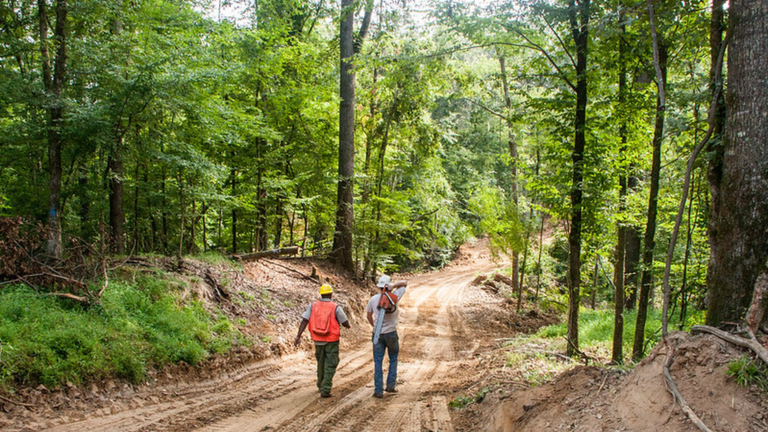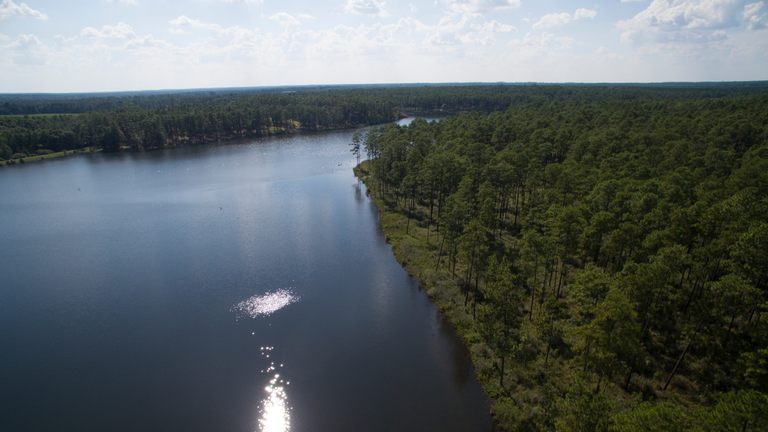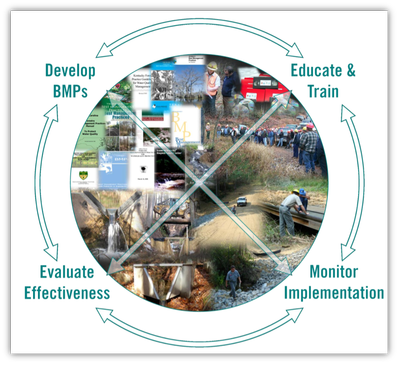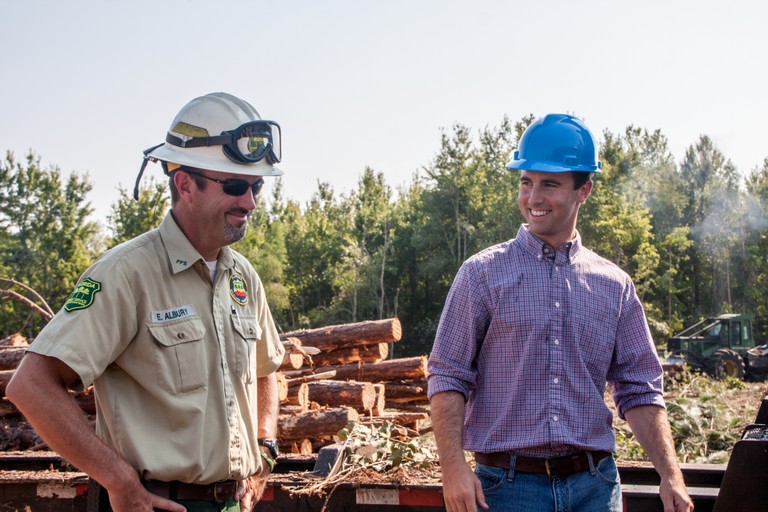Updates & Blog
Half a Century Since the Clean Water Act Amendments: The Success Story of Forestry Best Management Practices in the Southeast

Since its inception in 1972, the Clean Water Act has provided protection to waterbodies and has enabled the restoration of degraded waters to meet the needs of human use and ecological sustainability. The legacy of the Clean Water Act is often recalled as one of permitting, rules and limits on pollution discharges. However, one often overlooked aspect of the law’s benefits is the largely non-regulatory approach it takes to managing pollutants that may impact waterbodies from agricultural and forestry practices. This approach, known as nonpoint source (NPS) pollution management, is accomplished collaboratively through the application and monitoring of developed Best Management Practices (BMPs).
1950s – 1960s
By chance, forestry BMP research actually began much earlier, in the 1950s and 60s, when the Southern Region of the USDA Forest Service (USFS) identified several practical, low-cost and effective measures to improve operability of logging roads, skid trails and stream crossings. Although this effort was driven by a need to improve the efficiency and economics of access infrastructure needed to manage forestland, it turned out that many of the practices identified and tested also provided a high degree of water quality protection by also controlling erosion and minimizing sedimentation. Most of these studies were conducted long before anybody knew what a forestry BMP was or why they should use them. The Clean Water Act, though, provided the means for which BMPs could become formalized.
1970s – 1980s
At that point, states found themselves newly responsible for oversight of land use practices such as construction, farming, logging, stormwater runoff and wastewater disposal. Through the late 1970s and 80s, most southern states were well on their way to publishing their first generation of forestry BMPs, often pulling from agricultural and forest engineering practices developed by the USDA’s Soil Conservation Service and USFS. Non-regulatory preventative programs (e.g., voluntary BMPs) were favored over water quality monitoring programs, which would have only addressed problems after they occurred.
Adopting new BMPs in the forestry sector proved difficult at first – The idea that forestry activities would come under regulation by the federal government through the Clean Water Act’s requirements was a daunting proposition to those who had largely operated without much, if any, governance oversight. Through various early initiatives undertaken by states, and at the behest of the U.S. Environmental Protection Agency, BMPs became the cornerstone of the forestry sector’s actions to address NPS pollution during forest management.

The Clean Water Act’s method of managing NPS pollution is elegant in its balance between meeting the nation’s needs and federal government’s authority, and the sovereign rights of states, while encouraging industries to self-regulate. As such, the Clean Water Act and relevant federal rules establish baseline expectations under which each state develops its own processes, policies, permits, rules and/or BMP to avoid and minimize NPS pollution and wetland impacts. When the roll-out of new voluntary BMPs for agriculture and forestry came, it was a natural fit for the service-oriented state forestry agencies and their partners in cooperative extension to take the lead role. With state forestry agencies at the helm of BMP Implementation, accumulated trust formed the basis from which BMPs could be accepted and widely implemented. The true spirit of cooperation among the agencies, and with their core customers, allowed them to establish open, trusting and reliable relationships with landowners and industry operators, be it a farmer, rancher, forester or logger. The forestry community may not have initially understood why they needed to change their operations but trusted their state forestry agencies and extension services.
1980s – 1990s
Through the late 1980s and mid-1990s, all southern states had officially adopted forestry BMP recommendations – some states having progressed into their second generation BMPs. The attention now turned toward educating owners and operators. The majority of the southern states developed forestry BMP training videos, mostly addressing proper stream crossings, streamside management zones (stream buffers) and road construction.

At the close of the 20th Century, the forestry sector and environmental advocacy organizations developed independent forest certification programs that began to take a foothold in the southeastern U.S. These programs required members to abide by standards outlined therein, and included the provision that member companies must only hire loggers who have received verified training on the use of forestry BMPs. This market-driven self-governance through forest certification provided a built-in audience for state forestry agencies to deliver BMP training. Throughout the South, thousands of loggers and timber industry professionals needed BMP training to remain a member in good standing with the forest certification program to which that company subscribed. Third-party audits of each member company were (and are) conducted regularly to validate how each member company is complying with the certification program’s adopted standards.
Essentially, the concept of developing voluntary self-governed BMPs to control NPS pollution, as outlined by the Clean Water Act, has evolved over the past 50 years into a situation where those voluntary measures have become institutionalized as standard operating procedures through dedicated training and monitoring programs conducted by state forestry agencies, and widespread adoption by market-based, third-party, independently-audited forest certification programs, to which nearly all of the nation’s largest paper, lumber and timber companies subscribe.
2000 – Today

In 2007, the Southern Group of State Foresters (SGSF) established a framework which outlines basic expectations and suggested methods of conducting BMP implementation monitoring. The goal is to promote consistency among its member states in order to report collectively as a region on the use of BMPs. Starting in 2008, SGSF published a summary report of BMP implementation monitoring results among its member states, and has since published two follow-up reports. The implementation of voluntary BMPs consistently falls in the upper 80 to 90 percentiles across the South, in most instances. There is room for improvement for certain practices, but the expectation and adoption of BMPs is now incorporated as standard practice. States continue work in the development, refinement, training and monitoring of forestry BMPs. Most states have updated their forestry BMPs multiple times to keep up with changes in regulations, technology, science and socio-cultural expectations. As new loggers and forestry practitioners enter the workforce, there continues to be a need to train them. In addition, a new generation of forest owners is emerging and they will likely have different expectations and goals than their predecessors, and it will be important to educate these future forest owners on how BMPs can accomplish environmental goals while still incorporating the forest resource production needs of society.

The process by which states in the Southern Region monitor and report BMP implementation has been largely accepted by the U.S. Environmental Protection Agency, U.S. Fish and Wildlife Service, and other federal agencies. A growing body of research is helping to identify models, methods and assessments to answer that fundamental question. It is anticipated that within the next decade, the forestry sector should have the tools necessary to report on the degree to which BMPs were implemented and provide an informed estimate of how much pollutant was kept out of waterways.
The Clean Water Act redefined the nation’s expectations and recalibrated our awareness of the importance of keeping our waters clean. Forestry nonpoint source pollution management has successfully delivered results in a cooperative approach between federal, state, and private-sector constituents through the creation, development, delivery and monitoring of forestry Best Management Practices.
Authored by:
Tom Gerow, Jr. / Water Resources Staff Forester, N.C. Forest Service. Raleigh, NC.
AJ Lang / Watershed & Conservation Staff Forester N.C. Forest Service. Raleigh, NC.
Erik Schilling / Director of Forestry Research, Southeastern U.S., National Council for Air and Stream Improvement. Cross Roads, TX.